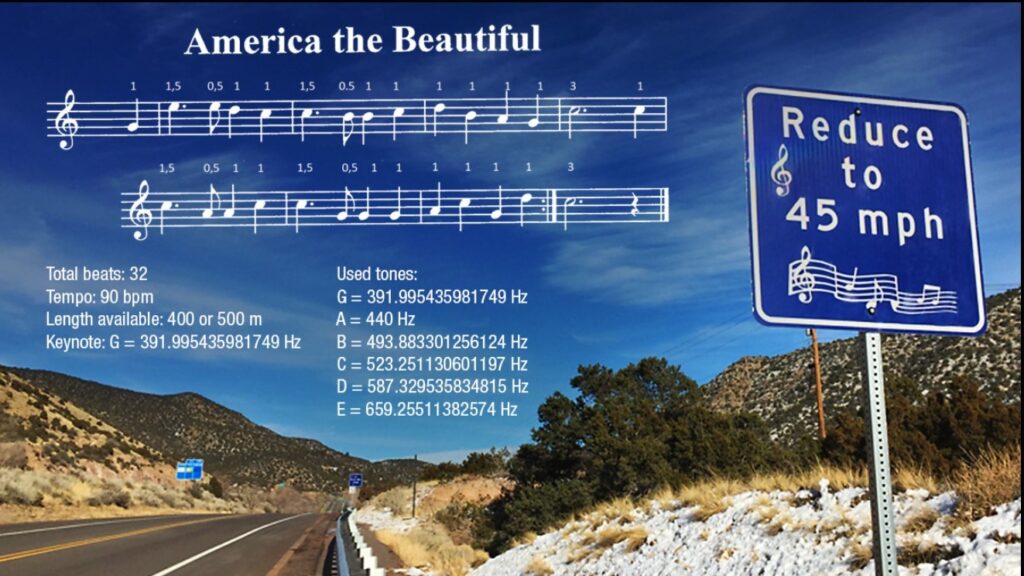
At the posted coordinates, get ready to experience the Musical Road. As soon as you see the sign, set your cruise control to 45 mph.
Drive east on Hwy 333 (Route 66). Look for the Musical Road signs between mileposts 4 and 5. This is shortly after Route 66 crosses to the south side of I-40. The road is only musical driving eastbound. This “Musical Highway” was installed in 2014 as part of a partnership between the New Mexico Department of Transportation and the National Geographic Channel. Enjoy the experience on the otherwise unremarkable stretch of the historic road. Driving on this road causes a vibration and audible tune transmitted through the vehicles’ wheels where and can be heard by the occupants.
RUMBLE STRIPS
Rumble strips are a road safety feature to alert inattentive drivers of potential danger, by causing a tactile vibration and audible rumbling transmitted through the wheels into the vehicle interior. There are four basic rumble strip designs or types: milled-in, raised, rolled-in, and formed. Research indicates milled rumble strips produce significantly more vibration and noise inside the vehicle than rolled rumbles. The tunes are created by the grooves, their depth, and spacing.
ROAD CLASSIFICATION
ASPHALT AKA BITUMEN … Very smooth road requiring four construction phases. In Phase 1, the landscape is graded, murrum consisting of fine gravels and soil is placed on the road, compacted, larger border stone is placed, screening fills in the spaces. In Phase 2, hot and molten bituminous mix is showered on the border filled with screening. In Phase 3, three to five inches of bitumen mixed with concrete covers the surface. In Phase 4, the road is compacted with rollers.
BRICK … The main ingredient of bricks is clay, a group of surface minerals that arise from the weathering of igneous rocks.
CONCRETE … This road is made up of cement, and stone gravels. It is durable, but does not provide friction between the road surface and the tires of the vehicle.
EARTHEN AKA DIRT … Very common in the countryside constructed from dirt and gravel.
GRAVEL … An unpaved road where the top of the road is covered with gravels. The gravels do not allow the rainwater to form mud.
KANKAR … An unpaved road made of limestone.
MURRUM … An unpaved road similar to earthen and gravel roads, but made of a mixture of soil, sand, gravels, and concrete.
WBMI – WATER BOUND MACADAM … Constructed with a stone border filled with sand mixed with soil and very fine gravel.
MATERIALS
BITUMEN … By-product of crude oil.
CLAY … Sediment formed from the weathering of igneous rock.
GRAVEL … Rock fragments commonly from sandstone, limestone, and basalt.
SAND … Formed from weathering of rock commonly made of quartz and feldspar.
SOIL … Composed of five ingredients — minerals, soil organic matter, living organisms, gas, and water.
RESOURCES
Asphalt Cement / Tar Pits / Tar Sands / National Geographic / Types of Roads / Musical Road / Musical Roads
LEARNING ADVENTURE
1. Based on the reading, select two types of materials used in road construction, and explain their geological origin.
2. Based on your observations, a. what type of road are you driving on? / b. Why was this type of road used to construct the Musical Road?
3. a. What other types of roads could be constructed to yield a Musical Road? / b. Explain your reasoning.
4. What is a different type of road you have travelled? Give coordinates, type of materials, and post picture.
MY ANSWERS
1. Clay from weathering of igneous rock. Gravel from rock fragments.
2. Asphalt used because it is a paved road and rumble strips could be etched into the smooth surface.
3. Only other one would be concrete. Rumble strips could not be etched into any of the other roads.
4. Brick – See GC635VR EarthCache Trail – Detective Bradford Area Shales
can’t wait to try this out. I will get their some time I hope before I’m to old to
enjoy it!!!!